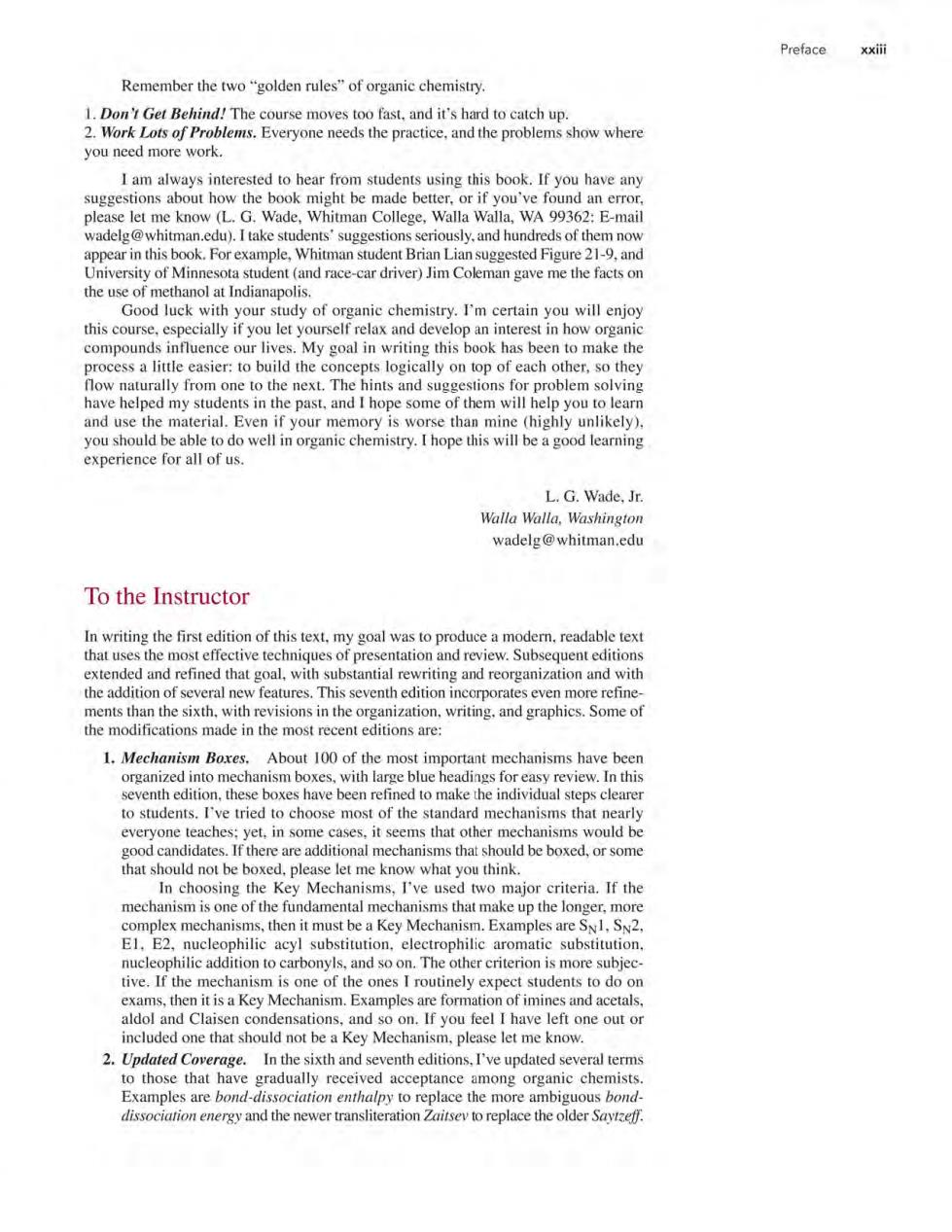正在加载图片...

Preface xxii Remember the two"golden rules"of organic chemistry 1.Don't Get Behind!The course moves too fast.and it's hard to catch up. 2.Work Lots of Problems.Everyone needs the practice,and the problems show where you need more work I am always interested to hear from students using this book.if you have an suggestions about how the book might be made better.or if you've found an error 心mc wadelg sbook.Fo 20n0 University of Minnesota student (and race-car driver)Jim Coleman gave me the facts or the use of methanol at Indianapolis. Good luck with your study of chemistry.I'm cerain you will enjoy this cess a little easier:to build the concepts log yonopoteachohes0they have helped my one to the next.The hints and ugproplem solving e past,and I e some o f them p you to lear good learning experience for all of us. .G.Wade,Jr WallaWalla,Washingto wadelg@whitman.edu To the Instructor In writing the first edition of this text.my goal was to produce a moder.readable text at goa ting and reorganiz on and Thi ments than the sixth.with revisions in the organization.writing.and graphics.Some of the modifications made in the most recent editions are: 1.Mechanism Boxes. seventhdition.these boxes have been refned to make heindividul stepsce to students.I've tried to choose most of the standard mechanisms that nearly that that should not be boxed.please let me know what you think. In choosing the Key Mechanisms,I've used two major criteria.If the mechanism is one of the fundamental me amples ar nuceolie addition to arbonls and so on.The otherriterion is more subie tive.If the mechanism is one of the ones I routinely expect students to do on amples are formation of In tha sisth and reeivedtpdted Examples are bond-dissociation enthalpy to replace the more ambiguous bond dissociation energy and the newer transliteration Zaitsey to replace the olderRemember the two "golden rules" of organic chemistry. 1. Don't Get Behind! The course moves too fast, and it's hard to catch up. 2. Work Lots of Problems. Everyone needs the practice, and the problems show where you need more work. I am always interested to hear from students using this book. If you have any suggestions about how the book might be made better, or if you've found an error, please let me know (L. G. Wade, Whitman College, Walla Walla, WA 99362: E-mail wadelg@whitman.edu). I take students' suggestions seriously, and hundreds of them now appear in this book. For example, Whitman student Brian Lian suggested Figure 21-9, and University of Minnesota student (and race-car driver) Jim Coleman gave me the facts on the use of methanol at Indianapolis. Good luck with your study of organic chemistry. I'm certain you will enjoy this course, especially if you let yourself relax and develop an interest in how organic compounds influence our lives. My goal in writing this book has been to make the process a little easier: to build the concepts logically on top of each other, so they flow naturally from one to the next. The hints and suggestions for problem solving have helped my students in the past, and I hope some of them will help you to learn and use the material. Even if your memory is worse than mine (highly unlikely), you should be able to do well in organic chemistry. I hope this will be a good learning experience for all of us. To the Instructor L. G. Wade, Jr. Walla Walla, Washington wadelg@ whitman.edu In writing the first edition of this text, my goal was to produce a modern, readable text that uses the most effective techniques of presentation and review. Subsequent editions extended and refined that goal, with substantial rewriting and reorganization and with the addition of several new features. This seventh edition incorporates even more refinements than the sixth, with revisions in the organization, writing, and graphics. Some of the modifications made in the most recent editions are: 1. Mechanism Boxes. About 100 of the most important mechanisms have been organized into mechanism boxes, with large blue headings for easy review. In this seventh edition, these boxes have been refined to make the individual steps clearer to students. I've tried to choose most of the standard mechanisms that nearly everyone teaches; yet, in some cases, it seems that other mechanisms would be good candidates. If there are additional mechanisms that should be boxed, or some that should not be boxed, please let me know what you think. In choosing the Key Mechanisms, I've used two major criteria. If the mechanism is one of the fundamental mechanisms that make up the longer, more complex mechanisms, then it must be a Key Mechanism. Examples are SN1, SN2, E1 , E2, nucleophilic acyl substitution, electrophilic aromatic substitution, nucleophilic addition to carbonyls, and so on. The other criterion is more subjective. If the mechanism is one of the ones I routinely expect students to do on exams, then it is a Key Mechanism. Examples are formation of imines and acetals, aldol and Claisen condensations, and so on. If you feel I have left one out or included one that should not be a Key Mechanism, please let me know. 2. Updated Coverage. In the sixth and seventh editions, I've updated several terms to those that have gradually received acceptance among organic chemists. Examples are bond-dissociation enthalpy to replace the more ambiguous bonddissociation energy and the newer transliteration Zaitsev to replace the older Saytzeff. Preface xxiii